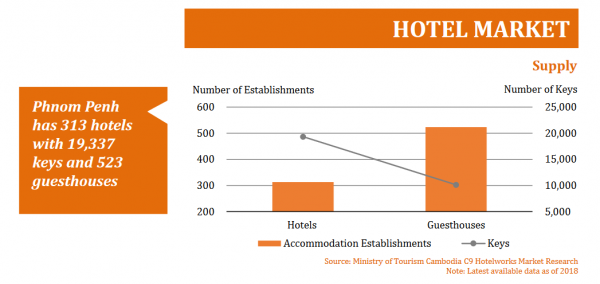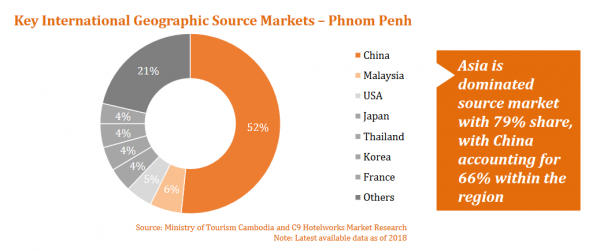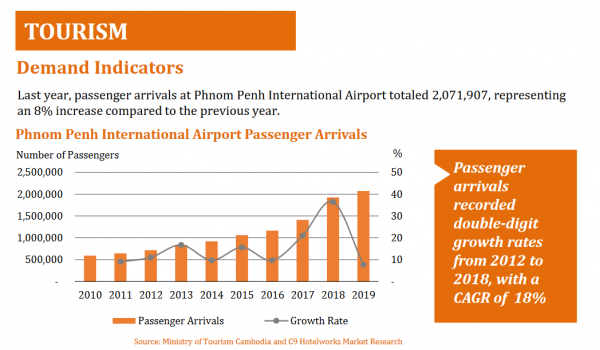SIEM REAP, 7 April 2020: As fast-paced urban development and sprawling mega-infrastructure projects appear on Phnom Penh’s skyline. The obvious question is, where does it go from here?
Cambodia’s shift from its singular tourism magnet Siem Reap, which is the access point for the World Heritage Angkor Wat and its historical park, is shifting rapidly southward to the nation’s capital city.
Last year, the lead indicator of airline passenger arrivals b saw Phnom Penh exceed 2 million surging past Siem Reap for the first time in a decade.


Research by hospitality consulting group, C9 Hotelworks, has also captured data showing a steady, sustained growth trajectory, as passenger arrivals recorded double-digit rate growth rates from 2012 through 2018, with a CAGR (compound annual growth rate) of 18%.
Clearly, the key catalyst of change for the city has been its proximity to the country’s leading private and public sector headquarters and strategic location for China’s ambitious BRI (Belt and Road Initiative. The BRI now spans across Cambodia and runs all the way south to the Gulf of Thailand and beyond into the South China Sea.

Citing the critical business and tourism potential of the city is C9’s newly released Phnom Penh Hotel Market Update 2020, which reports that Asia is the dominate visitor source region, representing a 79% market share. More telling is a deeper data dive that 66% of the regional traffic is from Mainland China. Ranking the top 5 geographic source markets has China at the top with 52%, followed in order by Malaysia, USA, Japan and Thailand.
According to C9’s report, there are 313 hotels with 19,337 keys and 523 guests houses in Phnom Penh. A clear sign of how fast-paced growth is impacting the hospitality sector is demonstrated in the fact that there are presently 15 new hotels in the pipeline with 7,849 keys.
It should be highlighted that 13 of the upcoming properties are internationally branded by global hotel management groups, including Marriott, Hyatt, Shangri-La and ACCOR.
Phnom Penh finds itself in a similar situation as other Asian CBD gateway capital hubs like Jakarta and Yangon, where hotels are defined by weekday business travellers.”
As for what are the prospects ahead C9hotelworks managing director Bill Barnett adds: “Cambodia’s new economic model remains unique in the region given the confluence of the BRI, though it’s sheer location is strategic by nature.
With a young emerging working class, and the influence of globalization, its economic history remains further in the future, so there remains a lot of work on the table in the foreseeable future.”
To read and download the full Phnom Penh Hotel Market Update 2020 click link below
https://www.c9hotelworks.com/downloads/phnom-penh-hotel-market-update-2020-04.pdf








There is a de facto ban. A covid-19 free certificate and health insurance to the tune of us$50000 is required.
Is Cambodia open to foreign tourism?
Couldn’t chase down any information that suggested Cambodia has a total travel ban in place except for the following statement by the country’s health authorities.
“The Cambodian Ministry of Health (MOH) announced 14 March a 30-day suspension of entry into Cambodia on “foreigners travelling from” the United States, France, Germany, Italy, and Spain. The suspension went into effect on Tuesday 17 March and has been extended until further notice.”
Even if you managed to find an international flight to Phnom Penh, the capital, you may discover you are required to quarantine for 14 days before you can travel in the country. You may not be able to leave the country when your 30-day visa expires due to the lack of flights or travel bans in third countries that you will need to pass through to connect with flights home. There are plenty of social media reports on stranded tourists in Cambodia who are seeking assistance from their embassies to get back home.